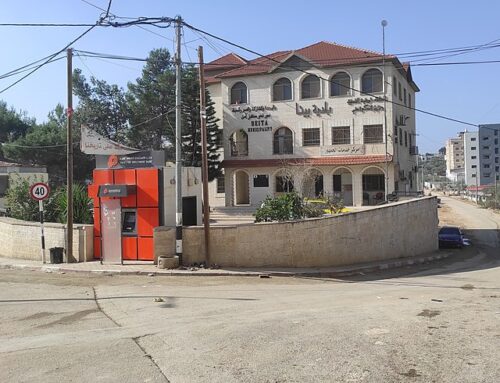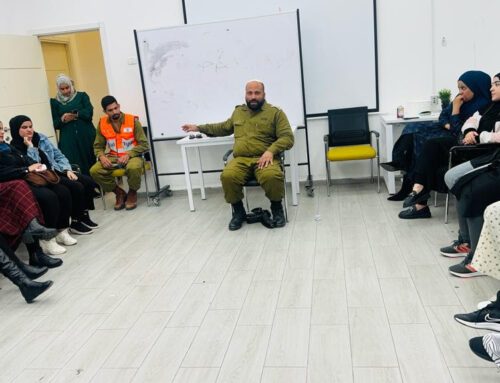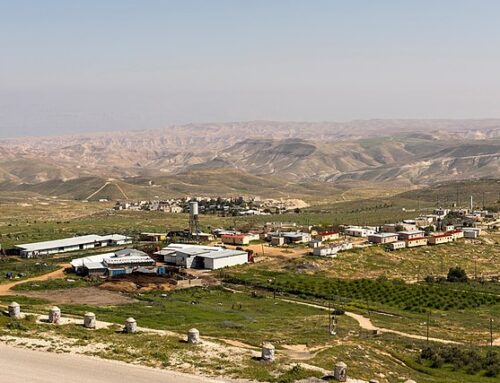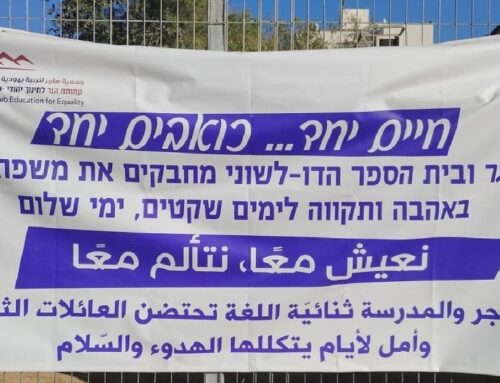Between June 11th, 2007 and June 14, 2007, Meretz USA partnered with the World Union of Meretz to sponsor an educational program in the West Bank for young American Jews. Twenty people participated in the trip, whose goal was to show the hardships of life under the Israeli occupation and to highlight the work of Israelis who work daily to change that reality.
The trip was premised on the desire of young progressive American Jews to travel to the Palestinian Territories and the lack of opportunities to do so with organizations not antagonistic to Israel. Although the trip revealed many injustices, it also highlighted a face of Israel deeply committed to social equality and peace. The tour guides included Israelis from the Geneva Initiative, Rabbis for Human Rights, Machsom Watch, Breaking the Silence, and Ta’ayush. They stressed the importance of showing the Palestinians, who typically only encounter Israelis soldiers or settlers, to Israelis and Jews concerned for their well being. Much of the trip painted a harsh reality, but it also showed the best of Israeli society.
June 11, 2007 – East Jerusalem
Day one of the Youth Symposium was spent in East Jerusalem, learning about the separation barrier with the Geneva Initiative, a joint Israeli-Palestinian effort that suggests a detailed peace agreement, and about home demolitions with Rabbis for Human Rights, which promotes social justice in Israel from a rabbinic perspective.
Throughout the morning, Noa, our guide from the Geneva Intiative, discussed the restrictions of the Occupation, asking whether or not they were all actually necessary for security. Pointing out small “settlements” – single houses purchased largely by an American from Miami named Irving Moskovitch, Noa also showed how some Jews are slowly trying to gain a foothold in East Jerusalem.
Most striking was a visit to the Arab neighborhood of Abu Dis, which is cut right down the middle by the Wall. It should be noted that the separation barrier is primarily made of fence, but around cities like Jerusalem, there are portions of it that are wall. Built on the line drawn after the Six Day War to define Jerusalem’s borders, the Wall does not take into consideration the neighborhoods which have long existed in its path.
The Wall severely disrupts the lives of the residents of Abu Dis. For instance, children who have school in the other section of town must travel a long distance for their education.
Moreover, the way in which the Wall has been constructed does little to make one believe it is necessary for security. Noa observed that it separates Arabs from Arabs, not Jews from Arabs. And with gaps where Palestinians can cross almost unhindered, the Wall does not even fully separate one side from the other. At the small checkpoint, Noah pointed out such a gap. There, she said, Palestinians could climb through, without being stopped by the soldiers standing right around the corner. As we left, Noa hypothesized that the wall functions more as a sign of power than a security barrier.
Following lunch, we met up with Rabbi Arik Asherman, Executive Director of Rabbis for Human Rights, for a very immediate and powerful look at the housing disputes taking place in East Jerusalem. We first visited a family whose house had been demolished that morning and then a family whose house was subject to repeated attempts by settlers to take it over.
When we got to the demolished house, the Red Cross was leaving having dropped off a tent, three mattresses, and some other provisions – a poor substitute for the home that had housed the family of ten. Rabbi Asherman explained that house demolitions frequently tear apart the families they affect – lowering the children’s esteem for the parents who were unable to prevent the tragedy.
The father of the family explained that the house had been built 10 years before, but that the Interior Ministry had told them three years ago that they needed to apply for a permit for the land. After years of struggle and much money spent, the army had notified them that morning of the impending demolition. The children had gone to school blissfully unaware of what would happen, and returned to find that they no longer had a home.
Before leaving, we helped them put up the tent. Even with the house demolished, they brought us cold drinks, welcoming us into what home they could.
Our final stop was a house in Silwan / Ir David. For the past week, settlers from the organization El ‘Ad had been attempting to take over the home in the sacred city, which rests on an important archaeological site.
One family member explained the complicated situation: They owned the house through “key money.” A form of rent control, key money means that the family living in a house has all the rights to the home, but are not the actually owners. One of the owners had supposedly sold the group of settlers her portion of the house. One week ago, the family had received a phone call notifying them they would have to leave. That evening, the El‘Ad settlers came to the house and tried to forcibly remove the family. The family had resisted, and was now taking the case to the court. But, for reasons that were unclear, multiple family members had been arrested and the court had not yet decided the verdict.
For now, the family, who had lived there for 50 years, is trying to hold onto their house against continued takeover attempts. At all times one member would be present in the house, and they were trying to get media attention for their cause.
Wishing them luck, we left, promising to tell their story.
June 12, 2007 – Hebron
On our second day, Yehuda Shaul of Breaking the Silence, a group of discharged Israeli soldiers speaking out against IDF abuses in the Territories, led us on a tour of Hebron, the site of a violent and ugly struggle between Palestinians and Israelis.
Hebron is divided into two sections: H1, which is under the control of the Palestinian Authority, and H2, which is under Israeli control. H2, where we spent our time, is home to all 600-800 settlers and some estimate 30,000 of the 120,000 Palestinians in the city – as more settlers have moved in, more Palestinians have been driven out.
Nevertheless, H2 is essentially a ghost town. Walking the streets of Hebron, we saw primarily military vehicles. Yehuda showed us pictures of the bustling city, taken 10 years ago. The pictures showed a stark contrast to the now deserted, boarded up, and ruined streets. These days, Hebron is almost entirely segregated. Palestinians cannot drive in 60% of the city and they cannot walk on certain streets. In some places, they must climb over several roofs just to get out of their houses and onto the streets. Many Palestinians are not allowed to own stores – in total about 2,200 are closed.
After being blocked by the army from visiting a Palestinian home inside the Hebron settlement of Tel Rumaida, we spoke briefly to the owner on the street. As he left to return to his shop, a settler, Baruch Marzel, came up to us, asking if we wanted to hear the other side. We said yes, and he explained to us that if the military lifted the restrictions, he would be happy to share the city with the Palestinians. It seemed an ironic encounter once we returned to Yehuda’s house and viewed a video, In God’s Bunker, where the same settler was shown quoting a song “have you killed an Arab today?” In reality, Marzel is the former leader of the outlawed Kach party, created by the right-wing radical Rabbi Meir Kahane. He has a long criminal record which includes assaults of Palestinians and even an Israeli police officer.
Before leaving Hebron, we stood on a hill and looked over the large portion of the city controlled by the Palestinians. The bustling area seemed entirely different from the eerily quiet place where we stood.
June 13, 2007 – The Checkpoints & South Mount Hebron
The third day of the Symposium was spent with Hanna Barag (who not so long ago spoke at Beit Shalom) of Machsom Watch, a group of women who go out each day to the checkpoints to document abuses and, to the best of their ability, to relieve Palestinian suffering, and later with Avichai Sharon of Ta’ayush, a group of Arabs and Jews working together to end the occupation and to achieve civil equality.
Hanna, a 70 year old grandmother, took us first to the Etzion District Commanding Office (DCO), which regulates the flow of Palestinians from Bethlehem who wish to work in the Gush Etzion settlement bloc. It is incredibly difficult to get a permit to do so – particularly for anyone under the age of 27 (because the Israelis have found that most suicide bombers are young people). Most Palestinians return to the DCO day after day without success.
However, getting a work permit is not the end to a Palestinian’s troubles. Frequently, employers deduct ahead of time the permit’s cost from the worker’s salary. Thus, if a Palestinian is unable to get to work one day – perhaps because of troubles at the checkpoints – the money has already been taken. He loses both that amount and his day’s salary.
That afternoon, we met up with Avichai to explore the South Mount Hebron area. The residents of the region are primarily Palestinian farmers and herders, who have lived in caves and shacks for generations. These are the “invisible people” – neither the Palestinian Authority nor the Israeli government looks out for their well being – and, in the area we visited, they are being moved to the city of Yatta as settlers come in and take their land.
Avichai explained that even seemingly small changes made by the Civil Administration have a strong impact on the Palestinians’ lives: in many areas, road guards have been put up. These guards come up to about mid-calf, but they are much larger barriers than they appear. The Palestinian livelihood relies largely on herding – and their sheep cannot climb over the barriers. Entire areas of grazing have been cut off.
June 14, 2007 – The Olive Groves
We had planned to visit Ramallah on the last day of Meretz USA’s Youth Symposium, but decided, at the last minute, to forgo the trip because of concern that the violence between Fatah and Hamas in the Gaza Strip might spill over. Instead, we visited Augusta Victoria Hospital on the Mount of Olives and joined once again with Rabbi Arik Asherman, this time to learn about the disputes centered around the olive groves.
At Augusta Victoria, we met with Reverend Mark Brown, the Regional representative of the Lutheran World Federation, which runs the hospital. Augusta Victoria treats primarily Palestinians, and about 90 – 95% of the patients come from outside Jerusalem. There, we heard about the medical problems facing the Palestinians, but, Revered Brown noted the biggest problem facing the Palestinians is a lack of freedom. Very few problems, he said, would remain unresolved were the occupation to end.
Picking up Rabbi Asherman from his office, we headed north to the Palestinian village of Qaryot, midway between Ramallah and Nablus. In the Qaryot municipal building, we listened to several community members. Qaryot lies between three settlements, which continue to grow, despite a law banning new settlements. Instead, existing ones build new “neighborhoods,” which land one or two miles away from the original settlement.
In addition to expanding the neighborhoods into Qaryot land, the settlers obstruct access to the village’s olive groves. In total, Qaryot residents can no longer get to 12,000 dunams (or about 3,000 acres) of land and about 3,000 adult olive trees. In order to harvest the olives that they still have access to, they are forced to travel long distances.
Wrapping up the trip, we returned to Jerusalem, having learned and seen things that few Americans – and even few Israelis – ever see. The Youth Symposium, sponsored by the Meretz USA and the World Union of Meretz, broadened the insight of its participants into the nuances of the occupation. Although terrorism is a legitimate and constant concern, the reality of Palestinian life is particularly bleak. Significantly, the trip also demonstrated the remarkable vision and commitment of the Israelis working for justice and the fulfillment of the Zionist ideal.






Thanks a lot, Amy, for your informative review of your recent trip to Israel. I, for one, was eager to read of your experiences and to learn some (unpleasant) new things, such as the plight of those Palestinians who “fall between the cracks” and are assisted by neither the Israel nor the Palestinian authorities. Yes, “bleak” is the right word for this frustrating, even maddening human situation, and I can feel for the people experiencing this even as I fear for my own life whenever they up the fear factor re terrorism on the nightly news here. It’s absolutely great to learn that, in the midst of all this, there are individuals and groups who are working tirelessly and hopefully for normality and for peace. What can one say but “Inshallah”… and also “God helps we who help ourselves,” and roll up our sleeves and pitch in on the side of good and on the side of peace. Here endeth the sermon… 🙂 Thanks again, Amy!